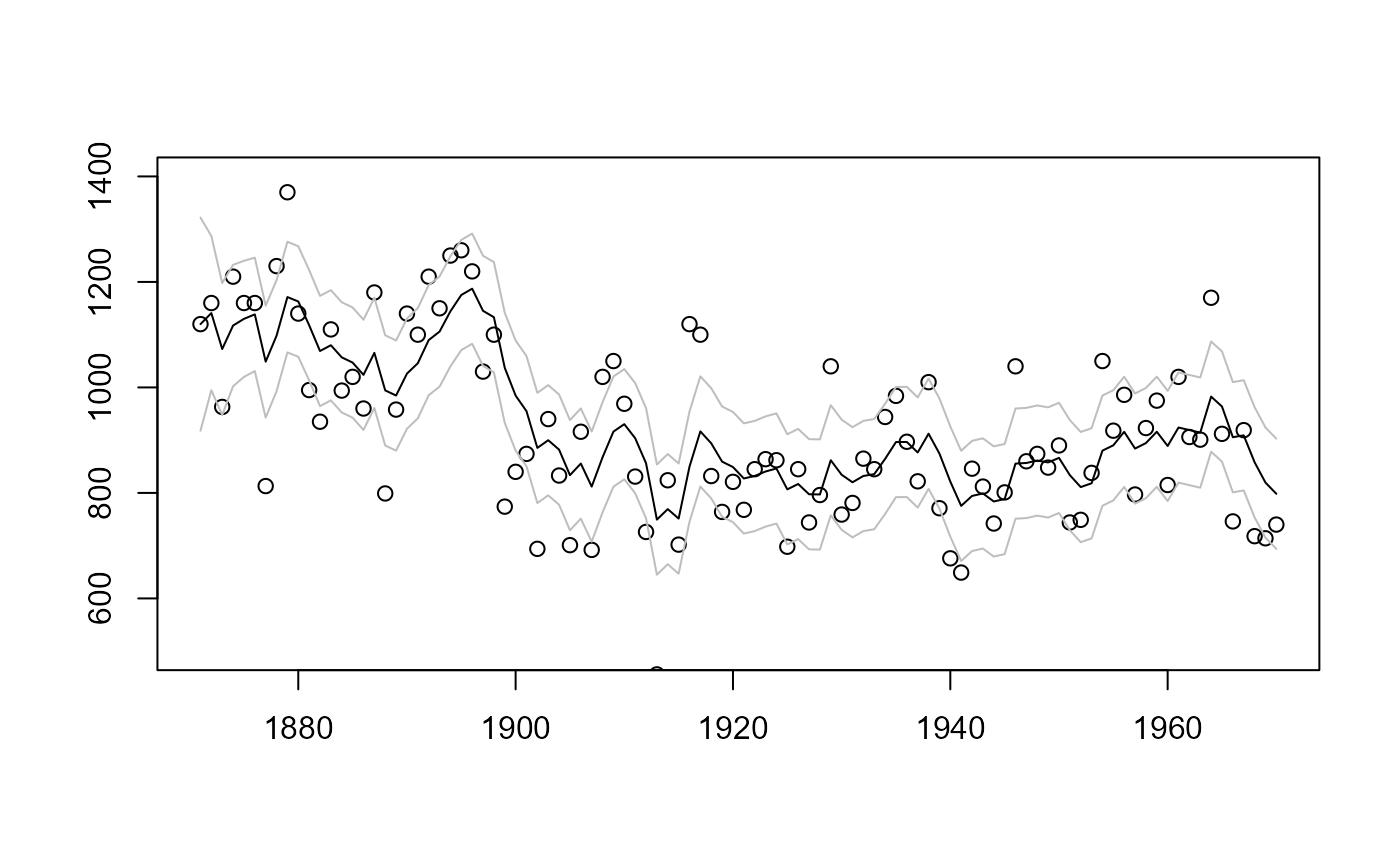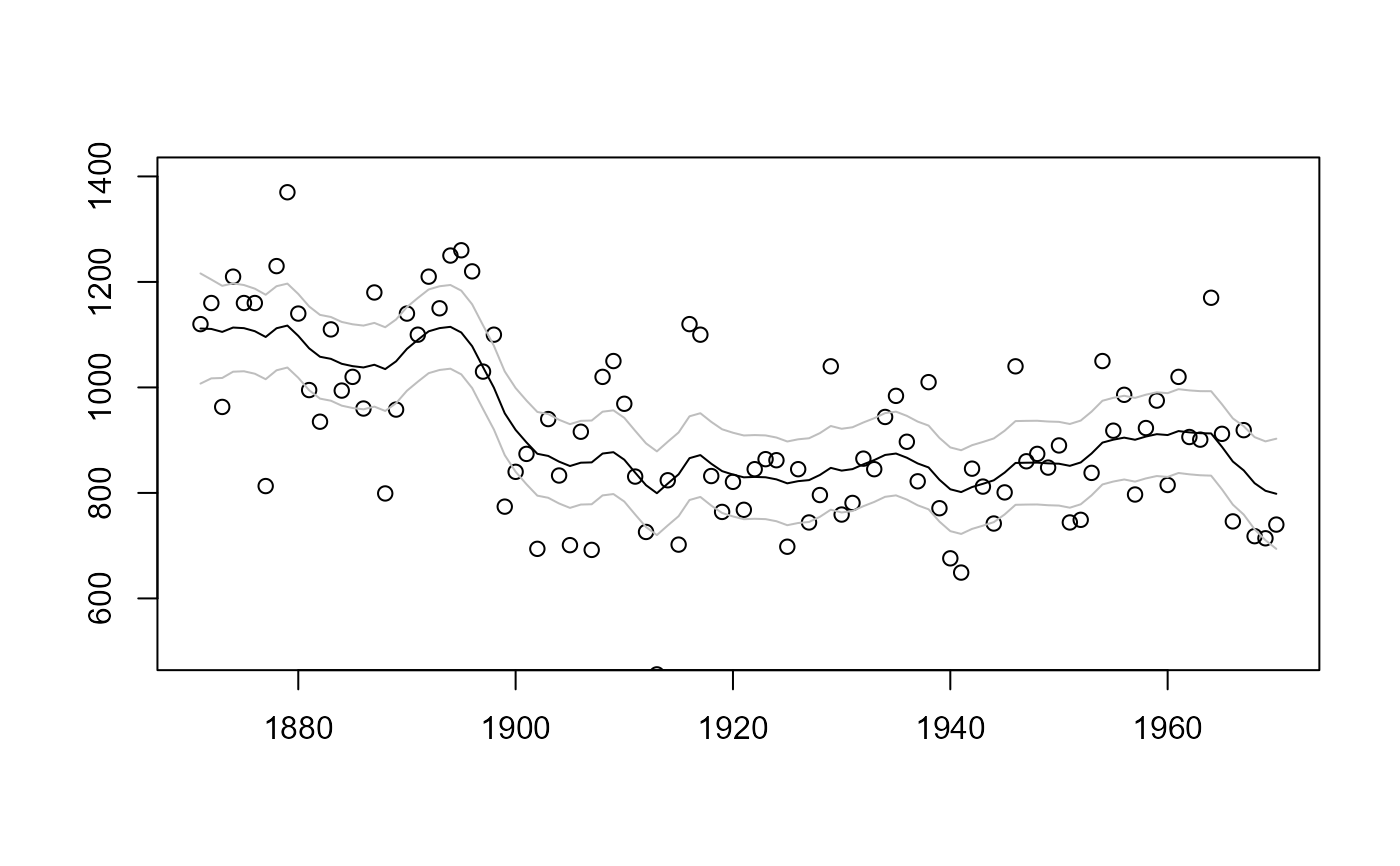Fits a State Space model as specified by the user.
statespacer(
y,
H_format = NULL,
local_level_ind = FALSE,
slope_ind = FALSE,
BSM_vec = NULL,
cycle_ind = FALSE,
addvar_list = NULL,
level_addvar_list = NULL,
arima_list = NULL,
sarima_list = NULL,
self_spec_list = NULL,
exclude_level = NULL,
exclude_slope = NULL,
exclude_BSM_list = lapply(BSM_vec, function(x) 0),
exclude_cycle_list = list(0),
exclude_arima_list = lapply(arima_list, function(x) 0),
exclude_sarima_list = lapply(sarima_list, function(x) 0),
damping_factor_ind = rep(TRUE, length(exclude_cycle_list)),
format_level = NULL,
format_slope = NULL,
format_BSM_list = lapply(BSM_vec, function(x) NULL),
format_cycle_list = lapply(exclude_cycle_list, function(x) NULL),
format_addvar = NULL,
format_level_addvar = NULL,
fit = TRUE,
initial = 0,
method = "BFGS",
control = list(),
collapse = FALSE,
diagnostics = TRUE,
standard_errors = NULL,
verbose = FALSE
)Arguments
- y
N x p matrix containing the N observations of the p dependent variables.
- H_format
Format of the H system matrix, the variance - covariance matrix of the observation equation.
- local_level_ind
Boolean indicating whether a local level should be added to the state space model.
- slope_ind
Boolean indicating whether a local level + slope should be added to the state space model.
- BSM_vec
Vector containing the BSM seasonalities that have to be added to the state space model.
- cycle_ind
Boolean indicating whether a cycle has to be added to the state space model.
- addvar_list
A list containing the explanatory variables for each of the dependent variables. The list should contain p (number of dependent variables) elements. Each element of the list should be a N x k_p matrix, with k_p being the number of explanatory variables for the pth dependent variable. If no explanatory variables should be added for one of the dependent variables, then set the corresponding element to
NULL.- level_addvar_list
A list containing the explanatory variables for each of the dependent variables. The list should contain p (number of dependent variables) elements. Each element of the list should be a N x k_p matrix, with k_p being the number of explanatory variables for the pth dependent variable. If no explanatory variables should be added for one of the dependent variables, then set the corresponding element to
NULL.- arima_list
Specifications of the ARIMA components, should be a list containing vectors of length 3 with the following format:
c(AR, I, MA). Should be a list to allow different ARIMA models for different sets of dependent variables. Note: The AR and MA coefficients are constrained such that the AR component is stationary, and the MA component is invertible. See Ansley and Kohn (1986) for details about the transformation used.- sarima_list
Specifications of the SARIMA components, should be a list containing lists that contain 4 named vectors. Vectors should be named: "s", "ar", "i", "ma". Should be a list of lists to allow different SARIMA models for different sets of dependent variables. Note: The AR and MA coefficients are constrained such that the AR components are stationary, and the MA components are invertible. See Ansley and Kohn (1986) for details about the transformation used. Note: For multivariate models, the order of "s" matters, as matrix multiplication is not commutative!
- self_spec_list
A list containing the specification of the self specified component. See the Details section for extensive details about the format that must be followed for this argument.
- exclude_level
Vector containing the dependent variables that should not get a local level.
- exclude_slope
Vector containing the dependent variables that should not get a slope.
- exclude_BSM_list
List of vectors, each vector containing the dependent variables that should not get the corresponding BSM component.
- exclude_cycle_list
The dependent variables that should not get the corresponding cycle component. Should be a list of vectors to allow different dependent variables to be excluded for different cycles.
- exclude_arima_list
The dependent variables that should not be involved in the corresponding ARIMA component. Should be a list of vectors to allow different dependent variables to be excluded for different ARIMA components.
- exclude_sarima_list
The dependent variables that should not be involved in the corresponding SARIMA component. Should be a list of vectors to allow different dependent variables to be excluded for different SARIMA components.
- damping_factor_ind
Boolean indicating whether a damping factor should be included. Must be a vector if multiple cycles are included, to indicate which cycles should include a damping factor.
- format_level
Format of the Q_level system matrix the variance - covariance matrix of the level state equation.
- format_slope
Format of the Q_slope system matrix, the variance - covariance matrix of the slope state equation.
- format_BSM_list
Format of the Q_BSM system matrix, the variance - covariance matrix of the BSM state equation. Should be a list to allow different formats for different seasonality periods.
- format_cycle_list
Format of the Q_cycle system matrix, the variance - covariance matrix of the cycle state equation. Should be a list to allow different formats for different cycles.
- format_addvar
Format of the Q_addvar system matrix, the variance - covariance matrix of the explanatory variables state equation.
- format_level_addvar
Format of the Q_level_addvar system matrix, the variance - covariance matrix of the explanatory variables of the level state equation.
- fit
Boolean indicating whether the model should be fit by an iterative optimisation procedure. If
FALSE, the model is only evaluated at the initial values.- initial
Vector of initial values for the parameter search. The initial values are recycled or truncated if too few or too many values have been specified.
- method
Method that should be used by the
optimoroptimrfunction to estimate the parameters. Only used iffit = TRUE.- control
A list of control parameters for the
optimoroptimrfunction. Only used iffit = TRUE.- collapse
Boolean indicating whether the observation vector should be collapsed. Should only be set to
TRUEif the dimensionality of the observation vector exceeds the dimensionality of the state vector. If this is the case, computational gains can be achieved by collapsing the observation vector.- diagnostics
Boolean indicating whether diagnostical tests should be computed. Defaults to
TRUE.- standard_errors
Boolean indicating whether standard errors should be computed. numDeriv must be installed in order to compute the standard errors! Defaults to
TRUEif numDeriv is available.- verbose
Boolean indicating whether the progress of the optimisation procedure should be printed. Only used if
fit = TRUE.
Value
A statespacer object containing:
function_call: A list containing the input to the function.system_matrices: A list containing the system matrices of the State Space model.predicted: A list containing the predicted components of the State Space model.filtered: A list containing the filtered components of the State Space model.smoothed: A list containing the smoothed components of the State Space model.diagnostics: A list containing items useful for diagnostical tests.optim(iffit = TRUE): A list containing the variables that are returned by theoptimoroptimrfunction.loglik_fun: Function that returns the loglikelihood of the specified State Space model, as a function of its parameters.standard_errors(ifstandard_errors = TRUE): A list containing the standard errors of the parameters of the State Space model.
For extensive details about the object returned,
see vignette("dictionary", "statespacer").
Details
To fit the specified State Space model, one occasionally has to pay careful
attention to the initial values supplied. See
vignette("dictionary", "statespacer") for details.
Initial values should not be too large, as some parameters use the
transformation exp(2x) to ensure non-negative values, they should also not
be too small as some variances might become relatively too close to 0,
relative to the magnitude of y.
If a component is specified without a format, then the format defaults to a
diagonal format.
self_spec_list provides a means to incorporate a self-specified component
into the State Space model. This argument can only contain any of the
following items, of which some are mandatory:
H_spec: Boolean indicating whether the H matrix is self-specified. Should beTRUE, if you want to specify the H matrix yourself.state_num(mandatory): The number of state parameters introduced by the self-specified component. Must be 0 if onlyHis self-specified.param_num: The number of parameters needed by the self-specified component. Must be specified and greater than 0 if parameters are needed.sys_mat_fun: A function returning a list of system matrices that are constructed using the parameters. Must haveparamas an argument. The items in the list returned should have any of the following names: Z, Tmat, R, Q, a1, P_star, H. Note: Only the system matrices that depend on the parameters should be returned by the function!sys_mat_input: A list containing additional arguments tosys_mat_fun.Z: The Z system matrix if it does not depend on the parameters.Tmat: The T system matrix if it does not depend on the parameters.R: The R system matrix if it does not depend on the parameters.Q: The Q system matrix if it does not depend on the parameters.a1: The initial guess of the state vector. Must be a matrix with one column.P_inf: The initial diffuse part of the variance - covariance matrix of the initial state vector. Must be a matrix.P_star: The initial non-diffuse part of the variance - covariance matrix of the initial state vector if it does not depend on the parameters. Must be a matrix.H: The H system matrix if it does not depend on the parameters.transform_fun: Function that returns transformed parameters for which standard errors have to be computed. Must haveparamas an argument.transform_input: A list containing additional arguments totransform_fun.state_only: The indices of the self specified state that do not play a role in the observation equations, but only in the state equations. Should only be used if you want to usecollapse = TRUEand have some state parameters that do not play a role in the observation equations. Does not have to be specified forcollapse = FALSE.
Note: System matrices should only be specified once and need to be
specified once! That is, system matrices that are returned by sys_mat_fun
should not be specified directly, and vice versa. So, system matrices need
to be either specified directly, or be returned by sys_mat_fun. An
exception holds for the case where you only want to specify H
yourself. This will not be checked, so be aware of erroneous output if you
do not follow the guidelines of specifying self_spec_list. If time-varying
system matrices are required, return an array for the time-varying system
matrix instead of a matrix.
References
Durbin J, Koopman SJ (2012). Time series analysis by state space methods. Oxford university press.
Ansley CF, Kohn R (1986). “A note on reparameterizing a vector autoregressive moving average model to enforce stationarity.” Journal of Statistical Computation and Simulation, 24(2), 99--106.
Examples
# Fits a local level model for the Nile data
library(datasets)
y <- matrix(Nile)
fit <- statespacer(initial = 10, y = y, local_level_ind = TRUE)
# Plots the filtered estimates
plot(
1871:1970, fit$function_call$y,
type = "p", ylim = c(500, 1400),
xlab = NA, ylab = NA
)
lines(1871:1970, fit$filtered$level, type = "l")
lines(
1871:1970, fit$filtered$level +
1.644854 * sqrt(fit$filtered$P[1, 1, ]),
type = "l", col = "gray"
)
lines(
1871:1970, fit$filtered$level -
1.644854 * sqrt(fit$filtered$P[1, 1, ]),
type = "l", col = "gray"
)
 # Plots the smoothed estimates
plot(
1871:1970, fit$function_call$y,
type = "p", ylim = c(500, 1400),
xlab = NA, ylab = NA
)
lines(1871:1970, fit$smoothed$level, type = "l")
lines(
1871:1970, fit$smoothed$level +
1.644854 * sqrt(fit$smoothed$V[1, 1, ]),
type = "l", col = "gray"
)
lines(
1871:1970, fit$smoothed$level -
1.644854 * sqrt(fit$smoothed$V[1, 1, ]),
type = "l", col = "gray"
)
# Plots the smoothed estimates
plot(
1871:1970, fit$function_call$y,
type = "p", ylim = c(500, 1400),
xlab = NA, ylab = NA
)
lines(1871:1970, fit$smoothed$level, type = "l")
lines(
1871:1970, fit$smoothed$level +
1.644854 * sqrt(fit$smoothed$V[1, 1, ]),
type = "l", col = "gray"
)
lines(
1871:1970, fit$smoothed$level -
1.644854 * sqrt(fit$smoothed$V[1, 1, ]),
type = "l", col = "gray"
)
